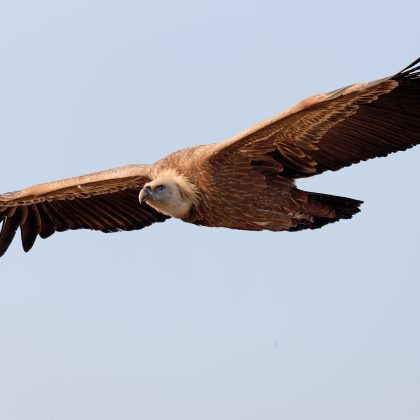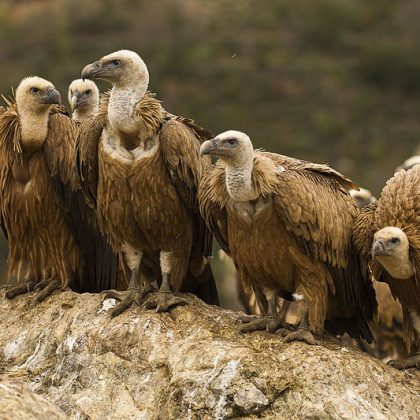South Asian vultures and diclofenac
Vultures are keystone species that perform a vital ecosystem service by disposing of carrion. Veterinary use of the painkilling drug diclofenac to treat livestock has caused the collapse of vulture populations throughout South Asia, with dramatic ecological and socio-economic consequences. Numerous influential papers documenting vulture declines, diagnosing the causes, developing solutions and testing their efficacy have been published in Bird Conservation International over the years.
Vultures perform a vital waste-clearing role that has major environmental and social benefits, such as removing odorous organic material and reducing the risk of disease transmission and water contamination. The stability of their populations is therefore of great importance to human society, as well as to natural ecosystems. Unfortunately, the positive impacts and essential services provided by vultures are often outweighed by negative perceptions stemming from their carcass-scavenging nature and association with death.

Until the early 1990s, Griffon vultures of the genus Gyps were abundant throughout South Asia, where populations were maintained by a plentiful supply of livestock carcasses. White-rumped Vulture G. bengalensis was considered one of the most abundant large raptors in the world. However, within a decade, the populations of three species – White-rumped, Indian G. indicus and Slender-billed Vultures G. tenuirostris – suddenly crashed. Surveys in India, Pakistan and Nepal confirmed that their populations had declined by more than 95% between 1992 and 2007, with White-rumped Vulture declining by a staggering 99.9% – the fastest decline of any still-extant bird species ever recorded.
In 2001, all three species were assessed as Critically Endangered on the IUCN Red List. Extensive research identified the cause of the decline to be diclofenac, a non-steroidal anti-inflammatory drug (NSAID) used widely in South Asia since the early 1990s as a veterinary painkiller to treat livestock. Experiments showed that vultures and other scavenging birds are highly susceptible to diclofenac, dying from renal failure after feeding on the carcasses of animals that die soon after being treated with the drug. Modelling revealed that only a tiny proportion of livestock carcasses need to contain diclofenac to explain the observed crash.

The loss of vultures has had huge socio-economic impacts across the region. Without vultures, millions of tons of animal carcasses have gone uneaten every year. Left to rot in the sun, they pose a serious risk to human health by providing a potential breeding ground for infectious diseases and encouraging the proliferation of pest species, such as rats. Most worryingly, the loss of vultures has resulted in a substantial increase in the number of feral dogs, whose bites are the most common cause of human rabies. One study estimated that the feral dog population in India has increased by least 5 million, resulting in over 38 million additional dog bites and more than 47,000 extra deaths from rabies, costing $34 billion.
In 2006, the Governments of India, Pakistan, and Nepal took action to ban diclofenac, and by 2008 the use, retail and manufacturing of the drug was an imprisonable offence in India. Pharmaceutical firms were encouraged to promote an alternative drug, meloxicam, which was shown to be safe for vultures and an effective treatment for livestock. The ban on diclofenac has had some success in reducing its prevalence, with before/after surveys showing reductions of 90% in Nepal and nearly 50% in India. This has significantly reduced the rate of decline of vulture populations, and in Nepal there are encouraging signs of sustained recovery.
In 2021, a second safe alternative (tolfenamic acid) was identified, providing another affordable out-of-patent option for veterinary use. Unfortunately, misuse of human forms of diclofenac (and another drug, aceclofenac, which is immediately metabolised into diclofenac in livestock) remains a significant threat to vultures, along with the widescale use in the region of other toxic NSAIDs such as nimesulide and ketoprofen, as well as other untested medicines.

Despite these ongoing threats, recent surveys suggest that vulture numbers are now recovering in Nepal, where diclofenac has most comprehensively been removed, and that declines have slowed or stopped in India (pending the results of the latest national survey) – related to the effectiveness of actions to ban diclofenac and to establish Vulture Safe Zones. Many of these actions have been implemented by a consortium of 25 Partners (including BirdLife International) working together on Saving Asia’s Vultures from Extinction (SAVE). Captive breeding programmes are also underway, with encouraging results and growing numbers, but most areas in India remain too high-risk for releases until drug regulation and implementation is significantly improved.
Wild populations remain very small across the region, and as vultures are slow-breeding birds, any recovery will be slow. All three Gyps vulture species are still listed as Critically Endangered, and their extinction remains a very real possibility, making continued conservation action vital to ensure the persistence of species of such huge ecological importance.
Many of the key scientific papers on South Asian vultures and diclofenac have been collated in this month’s sixth centenary collection of BCI papers, made freely available by Cambridge University Press for a limited period to mark the 100th anniversary of BirdLife International. This collection is released in September, the same month as the annual International Vulture Awareness Day.
Ian Burfield, Global Science Coordinator (Species), BirdLife International
Chris Bowden MBE, SAVE Programme Manager, RSPB






